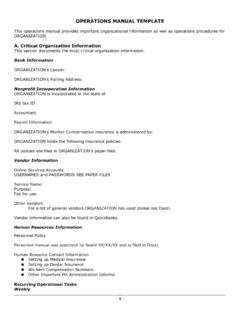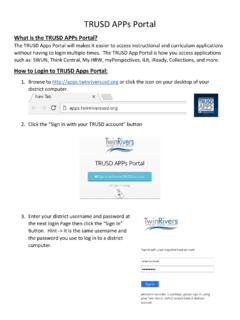Transcription of Safeguarding Taxpayer Data - IRS tax forms
1 1A GUIDE FOR YOUR BUSINESSS afeguardingTaxpayer DataSAFEGUARDING Taxpayer DATA2 ContentsIntroduction Safeguarding Taxpayer data ..3 Protect Your Clients; Protect YourselfTake Basic Security Steps ..4 Use Security Software ..5 Create Strong Passwords ..5 Secure Wireless Networks ..6 Protect Stored Client data ..7Be on GuardSpot data EFIN/PTIN ..8 Recognize Phishing Scams ..9 Guard Against Phishing Emails ..10Be Safe on the Internet ..10 Report and RespondReport data Loss to IRS/States ..11 Respond and Recover from a data Loss ..12 Comply with the FTC Safeguards RuleUnderstand the FTC Safeguards Rule ..13 Comply with the FTC Safeguards Rule ..13 Use the Safeguards Rule Checklist ..14 Employee Management and Training ..14 Information Systems ..15 Detecting and Managing System Failures ..16 Glossary ..18 Safeguarding Taxpayer DATA3 Introduction - Safeguarding Taxpayer DataCombatting today s cybercriminals takes all of us working together.
2 The Internal Revenue Service works with state tax agencies and the tax industry to fight these 21st century identity thieves. After forming the Security Summit and enacting a series of safeguards, the partners are making inroads. But, there s more work to be done. data thefts at tax professionals offices are on the rise. As the Security Summit makes progress, identity thieves need more Taxpayer data to file fraudulent tax returns. And they have placed tax practitioners firmly in their sights. data security is now a necessity for every tax professional, whether a partner in a large firm or a sole practitioner, and every Authorized IRS e-File Provider. Every employee, both professional and administrative staff, should be educated about security threats and safeguards. Everyone has a role to play in protecting Taxpayer Taxpayer data is the law.
3 Federal law gives the Federal Trade Commission authority to set data safeguard regulations for various entities, including professional tax return preparers. According to the FTC Safeguards Rule, tax return preparers must create and enact security plans to protect client data . Failure to do so may result in an FTC investigation. Online providers also must follow the six security and privacy standards in Publication 1345, Handbook for Authorized IRS e-file Providers of Individual Income Tax Returns. Protecting Taxpayer data is good business. data security can protect your business as well as your clients. A theft may also mean a loss of reputation, a loss of clients or a loss of money. Consider engaging security professionals for assistance or check with your professional liability carrier about data theft coverage.
4 This guide seeks to help tax professionals to: understand basic security steps and how to take them; recognize the signs of data theft and how to report data theft; respond and recover from a data loss; understand and comply with the FTC Safeguards Rule. Safeguarding Taxpayer DATA4 Protect Your Clients; Protect YourselfTake Basic Security Steps Here are some basic security steps that tax professionals can take today to make their clients data and their businesses safer: Learn to recognize phishing emails, especially those pretending to be from the IRS, e-Services, a tax software provider or cloud storage provider. Never open an embedded link or any attachment from a suspicious email. Create a data security plan using IRS Publication 4557, Safeguarding Taxpayer data , and Small Business Information Security The Fundamentals, by the National Institute of Standards and Technology.
5 Review internal controls: Install anti-malware/anti-virus security software on all devices (laptops, desktops, routers, tablets and phones) and keep software set to automatically update. Use strong passwords of 8 or more characters, use different passwords for each account, use special and alphanumeric characters, use phrases, password protect wireless devices and consider a password manager program. Encrypt all sensitive files/emails and use strong password protections. Back up sensitive data to a safe and secure external source not connected fulltime to a network. Make a final review of return information especially direct deposit information - prior to e-filing. Wipe clean or destroy old computer hard drives and printers that contain sensitive data . Limit access to Taxpayer data to individuals who need to know.
6 Check IRS e-Services account weekly for number of returns filed with EFIN. Report any data theft or data loss to the appropriate IRS Stakeholder Liaison. Stay connected to the IRS through subscriptions to e-News for Tax Professionals, QuickAlerts and Social Taxpayer DATA5 Use Security Software A fundamental step to data security is the installation and use of security software on your computers. Here are the various types of security software you need and their purpose: Anti-virus prevents bad software, such as malware, from causing damage to a computer. Anti-spyware prevents unauthorized software from stealing information that is on a computer or processed through the system. Firewall blocks unwanted connections. Drive Encryption protects information from being read on computers, tablets, laptops and smart phones if they are lost, stolen or improperly Windows and Mac operating systems come with factory-installed security software and with encryption technology.
7 Both operating systems also come with built-in firewall protection, which you should enable unless your anti-virus software includes a firewall feature. Or, you also may separately purchase security software that offers a suite of product recommendations, check with colleagues, professional associations or, for those who have data theft insurance protection, the insurance carrier. Never select security software from a pop-up advertisement while surfing the web. Download security software only from the chosen vendor s site. Set security software to update automatically. This step is critical to ensuring the software has the latest protections against emerging threats. For additional safety, ensure that your internet browser (Google, MS EDGE, Firefox, Safari, etc.) is set to update automatically so that it remains Strong PasswordsIt is critical that all tax practitioners establish strong, unique passwords for all accounts, whether it s to access a device, tax software products, cloud storage, wireless networks or encryption technology.
8 Here s how to get started: Use a minimum of eight characters; longer is better. Use a combination of letters, numbers and symbols, , ABC, 123, Avoid personal information or common passwords; opt for phrases. Change default/temporary passwords that come with accounts or devices, including Taxpayer DATA6 Do not reuse passwords, , changing Bgood!17 to Bgood!18 is not good enough; use unique usernames and passwords for accounts and devices. Do not use your email address as your username if that is an option. Store any password list in a secure location such as a safe or locked file cabinet. Do not disclose your passwords to anyone for any reason. Use a password manager program to track passwords, but protect it with a strong it is an option, a multi-factor authentication process for returning users should be used to access accounts.
9 Some providers of tax software products for tax professionals offer two-factor or even three-factor authentication. Use the most secure option available, not only for your tax software, but other products such as email accounts and storage provider accounts. An example of two-factor authentication: you must enter your credentials ( username and password ) plus a security code sent as a text to your mobile phone before you can access an hosting your own website, also consider some other form of multi-factor authentication to further increase your login Wireless Networks Failing to protect your wireless network makes the network or data vulnerable to attack or interception by cybercriminals. Thieves could be stealing your data without your knowledge. You can take these protective steps with setting up your router or review your router s manual to make changes.
10 Here are basic steps to protect your wireless network: Change default administrative password of your wireless router; use a strong, unique password . Reduce the power (wireless range) so you are not broadcasting further than you need. Log into your router to WLAN settings, advanced settings and look for Transmit (TX) power. The lower the number the lower the power. Change the name of your router (Service Set Identifier - SSID) to something that is not personally identifying ( , BobsTaxService), and disable the SSID broadcast so that it cannot be seen by those who have no need to use your network. Use Wi-Fi Protected Access 2 (WPA-2), with the Advanced Encryption Standard (AES) for encryption. Do not use Wired-Equivalent Privacy (WEP) to connect your computers to the router; WEP is not considered secure.


















